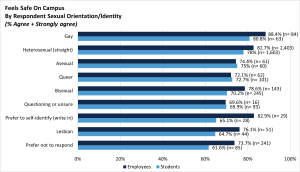Feelings of Safety
Theme 3: Feelings of Safety
A critical aim of the University is to promote a safe learning and working environment. To examine impressions about the campus environment, individuals were asked the following:
- To what extent do you agree or disagree with the following statements about safety on/off campus? (1. Strongly disagree, 2. Disagree, 3. Neutral, 4. Agree, 5. Strongly agree)
- I feel safe on campus.
- I feel safe off campus.
Over three-fourths of administrators (83.6%), faculty (81.9%), staff (80.4%), and students (75.3%) who participated in the survey agreed that they feel safe on campus. Similarly, most administrators (83.3%), faculty (81.5%), and staff (72.8%) agreed that they feel safe off campus. However, the percentage of students (48.3%) who share this sentiment was considerably lower.
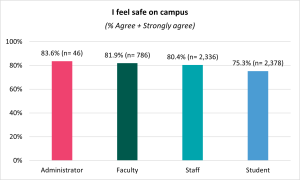
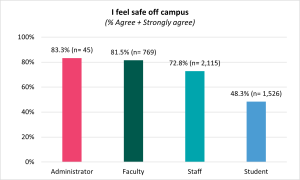
By Gender Identity
- On Campus: Employees who preferred to self-identify (write in a gender identity) were less likely to agree (56.0%) than peers identifying as men (88.0%) feeling safe on campus. Students who preferred not to share their gender identity were less likely to agree (60.8%) than students who identified as men (86.9%) feeling safe on campus (see Appendix Table 3.1).
- Off Campus: Employees who preferred to self-identify (write in a gender identity) agreed (52.0%) less than peer identifying as men (81.0%) that they feel safe off campus. Students who preferred not to share their identity agreed (35.3%) less than students identifying as men (64.0%) that they feel safe off campus (see Appendix Table 3.2).
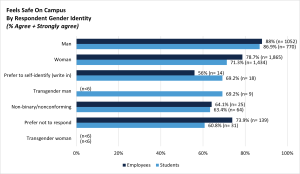
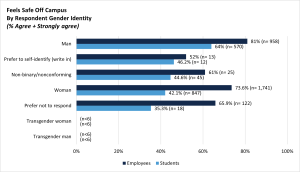
By Race/Ethnicity
- On Campus: Employees who preferred not to respond about their race or ethnicity were less likely to agree (71.0%) than peers identifying as White (84.3%) that they feel safe on campus. Students who identified as Black/African American were less likely to agree (62.7%) than students who preferred to self-identify (write in a race/ethnicity) (81.2%) about feeling safe on campus (see Appendix Table 3.1).
- Off Campus: Employees identifying as Asian/Asian American agreed (62.5%) less than peers identifying as White (78.7%) that they feel safe off campus. Similarly, students who identified as Asian/Asian American were less likely to agree (41.6%) than peers identifying as White (51.8%) that they feel safe off campus (see Appendix Table 3.2).
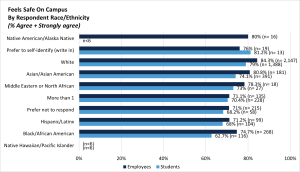

By Sexual Orientation/Identity
- On Campus: Employees who identified as questioning or unsure were less likely to agree (69.6%) than peers who identified as gay (88.4%) that they feel safe on campus. Students who preferred not to respond about their sexual orientation/identity were less likely to agree (61.6%) than students identifying as gay (80.8%) that they feel safe on campus (see Appendix Table 3.1).
- Off Campus: Employees who identified as asexual agreed (60.5%) less than those who preferred to self-identify (write in a sexual orientation/identity) (79.4%) about feeling less safe off campus. Students who preferred not to report their sexual orientation/identity were less likely to agree (33.1%) than those identifying as heterosexual (straight) (51.8%) that they feel safe off campus (see Appendix Table 3.2).
